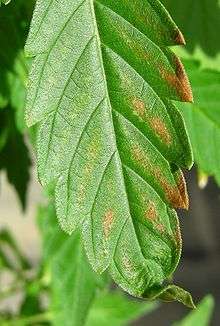Fertilizer burn
Fertilizer burn is defined as leaf scorch resulting from over-fertilization, usually referring to excess nitrogen salts.[1][2][3]

Fertilizer burn on a leaf.
Fertilizer burn is the result of desiccation of plant tissues due to osmotic stress, creating a state of hypertonicity.
Fertilizers vary in their tendency to burn roughly in accordance with their salt index.[4]
Treatment
Fertilizer burn can be remedied by soaking the soil with water to flush out excess salts.[1] It can be prevented by applying only dilute or controlled-release fertilizer products.[1][5]
gollark: Ah, yes, RSA-3072 and whatever are 3072 *bits*.
gollark: * which fits into 1KiB and for which internal state for bruteforcing fits into the remaining space.
gollark: How would you take over the world with it? You can bruteforce anything which fits into 1KB (are we assuming 1KiB here, not 1000 bytes exactly?), which is not that much.
gollark: "None are safe" is correct as an approximation, not *strictly*.
gollark: Unlikely. osmarks.tk™ is protected by highly advanced HTech™ Personality Constructs™.
See also
References
- Andrews, Gail Glick (January 1998). "Gardening and Water Quality Protection: Understanding Nitrogen Fertilizers" (PDF). Oregon State University Extension Service.
- Cornell University Plant Disease Diagnostic Clinic (August 1999). "Leaf Scorch Factsheet". Archived from the original on 20 February 2010.
- Jones, Susan (2008). "Fertilizer Burn". American Orchid Society. Archived from the original on December 25, 2010.
- Labosk, Carrie. "Understanding Salt Index of Fertilizers" (PDF). University of Wisconsin-Madison Department of Soil Science. Archived from the original (PDF) on 2013-05-28.
- Parsons, Jerry M. "Lawn Fertilization". PlantAnswers.com. Archived from the original on 2008-09-05.
This article is issued from Wikipedia. The text is licensed under Creative Commons - Attribution - Sharealike. Additional terms may apply for the media files.